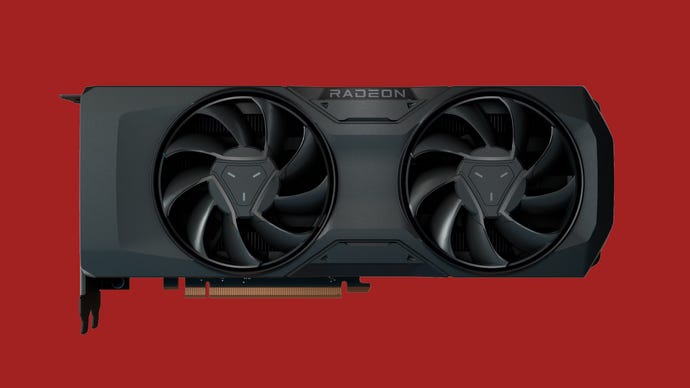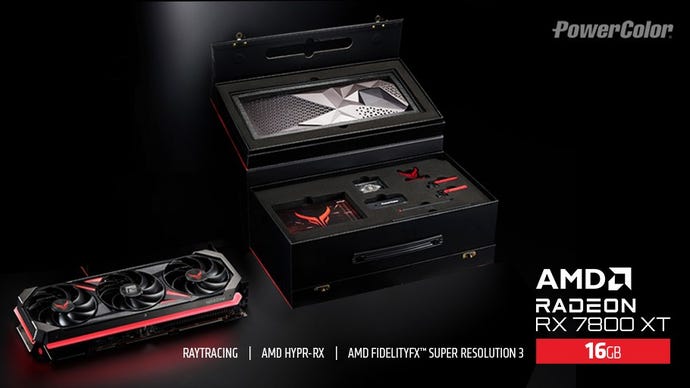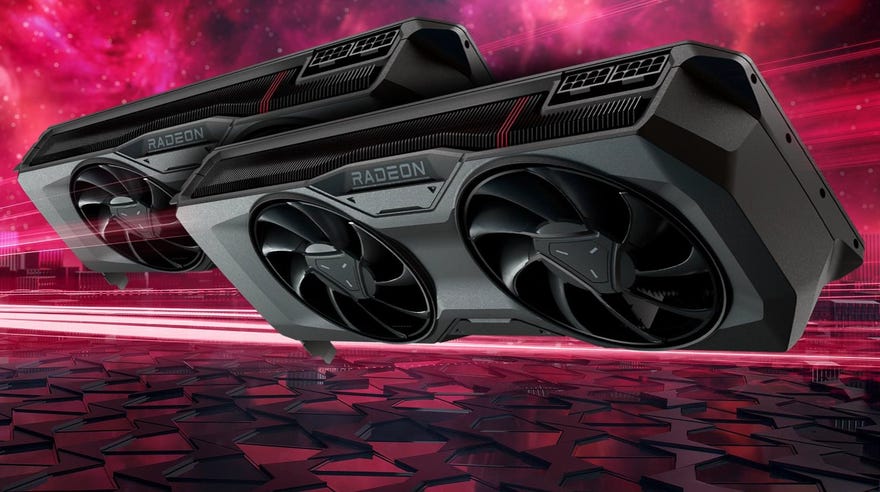AMD Radeon RX 7700 XT & RX 7800 XT price, specs, release date, and features
RDNA 3 mid-rangers want a piece of the 1440p pie
AMD will finally plug a yawning great hole in the middle of their RDNA 3 graphics card lineup, with both the Radeon RX 7700 XT and Radeon RX 7800 XT set to launch in September. Intended as RTX 4060 Ti and RTX 4070 botherers, you can expect these GPUs to put in a shift at high-quality 1440p, with a view towards FSR 3 making up for their lack of Nvidia DLSS 3 support.
Hopefully these make a more aggressive play for greatness than the RX 7600 did; that GPU was a merely adequate 1080p tool that barely outperformed the old RX 6650 XT. We’ll find out once I can get them in my grasping hands for testing, but in the meantime, here’s everything worth knowing about the Radeon RX 7700 XT and RX 7800 XT – including prices, specs, and AMD’s performance claims.

AMD Radeon RX 7700 XT & RX 7800 XT: Price
While we wait for the TBC UK pricing, let us stroke our chins at what you’ll pay for the RX 7700 XT and RX 7800 XT in the US and Europe. The RX 7700 XT will start from $449 / €489, and the RX 7800 XT will sell from $499 / €549.
I know one shouldn’t make value judgements on a graphics card before seeing how it runs, but... if the RX 7800 XT really can keep pace with an RTX 4070, that’s going to put it in a mighty commanding position next to Nvidia’s $599 GPU. The RX 7700 XT is only $50 cheaper, too – if anything I can see that one being cannibalised by RX 7800 XT buyers who don’t mind saving up a few more notes for the higher tier model.
It's also worth noting that the RX 7700 XT is only cheaper than 16GB version of the RTX 4060 Ti; next to the $399 8GB model, it’s going to be a much harder sell, especially to anyone who wants a max-quality 1080p machine rather than a 1440p one. The RX 7700 XT does at least have 12GB of VRAM, so it’s kind of appropriate that its pricing lies between the 8GB and 16GB RTX 4060 Tis.

AMD Radeon RX 7700 XT & RX 7800 XT: Release date
Both the RX 7700 XT and RX 7800 XT are releasing on September 6th 2023. Oh, hey, like Starfield – and that’s probably no coincidence. AMD and Bethesda have been palling around recently, with themed hardware and the bigging-up of Starfield’s FSR 2 support, so the launch of these GPUs is sure to involve more plugging for the spacefaring RPG.
Indeed, it’s already confirmed that buying an RX 7700 XT or RX 7800 XT will net you a free copy of Starfield. Granted, that’s already been the case for many existing Radeon graphics cards, as well as AMD Ryzen CPUs.

AMD Radeon RX 7700 XT & RX 7800 XT: Specs
A glance through these cards’ specs lists does little to explain why they’re invading each others’ personal price space. For only $50 more, the RX 7800 XT looks drastically superior in almost every way, sporting more processing cores, Compute Units (CUs), and 25% more memory. By AMD’s own admission, it also only uses slightly more power than the RX 7700 XT, while having the same PSU requirement.
| AMD Radeon RX 7700 XT | AMD Radeon RX 7800 XT | |
|---|---|---|
| VRAM | 12GB GDDR6 | 16GB GDDR6 |
| Stream Processors | 3456 | 3840 |
| Game Frequency | 2171MHz | 2125MHz |
| Compute Units | 54 | 60 |
| Ray Accelerators | 54 | 60 |
| AI Accelerators | 108 | 120 |
| Infinity Cache | 48MB | 64MB |
| Typical Board Power | 245W | 263W |
| Minimum recommended PSU | 700W | 700W |
Speaking of which, the 700W minimum is surprisingly onerous, given the RDNA 3 architecture is supposed to make significant efficiency improvements (along with the more performance-minded changes over RDNA 2, like having the CUs do more calculations per second). The RTX 4070 only asks for a 650W PSU, while the 16GB RTX 4060 Ti only wants 550W.
More positively, there is quite a lot more stuff crammed into these cards than on their RX 6000 equivalents. The RX 6750 XT, for instance, only had 2560 stream processors, 40 CUs, and 40 ray accelerators to its name. Here’s hoping such changes amount to a bigger leap forward than the RX 7600 made.

AMD Radeon RX 7700 XT & RX 7800 XT: Performance
As per usual with just-announced components, our only sources of info on how the RX 7700 XT and RX 7800 XT perform are the people who make them. That doesn’t mean you need to scoff at the following graphs as if they were declaring that the sky is magenta, but it’s always good to maintain a healthy skepticism with 'official' performance figures.
During the reveal event at Gamescom 2023, AMD opened up with a comparison showing both GPUs soundly (and expectedly) thrashing the old RTX 2070 Super. Possibly useful to any current RTX 2070 Super owners looking to upgrade, but not very illuminating in terms of how the RX 7000 series’ new mid-range would compete with younger rivals on the market. Luckily, what followed next was exactly that.
Here’s how, according to AMD, the RX 7700 XT stacks up against the 16GB RTX 4060 Ti when running games at 1440p. Click to make bigger, if needed:

Now here’s the RX 7800 XT versus the RTX 4070, also at 1440p:

Again, these numbers aren’t as useful without knowing exactly what settings these benchmarks were taken at, but there is a confidence here that was completely absent from the RX 7600 reveal; I can’t recall AMD ever making such direct, and largely favourable, comparisons between that GPU and the RTX 4060. In both cases, the RX 7700 XT and RX 7800 XT are claiming big wins over more expensive Nvidia hardware, and that’s not insignificant even at this early stage.
That said, several of the listed games support DLSS 3, which would give the RTX 40 series an added performance boost – one that the RX 7700 XT and RX 7800 XT won’t be able to match at launch, or indeed until FSR 3 becomes much more widely implemented. All of AMD’s benchmarks use native 1440p, so aren’t taking upscalers (or their associated frame generation features) into account.

AMD Radeon RX 7700 XT & RX 7800 XT: Features
Nonetheless, FSR 3’s potential remains high, and these new GPUs will be more prepared for it than most. In exchange for frame generation’s higher FPS counts, it will introduce input lag, just as DLSS 3 does; as RX 7000 cards, however, the RX 7700 XT and RX 7800 XT will also be able to use Radeon Anti-Lag+. This is the newest and most effective version of AMD’s latency reduction tech, so in theory it should help offset the added lag that comes with frame generation, keeping your mouse movements feeling sharp.
Frame gen isn't the only new tool in FSR 3's kit, either. There's also Native AA mode, an equivalent of Nvidia DLAA where you can choose to disable FSR 3's upscaling (thus rendering the game at your monitor's usual, native resolution) but keep its built-in anti-aliasing. Just like DLAA, this could make sense in games that already run well enough without the need for upscaling, but use flawed AA systems themselves. Frame gen will still work while Native AA mode is active, too.

Where FSR 3 nor any other in-game upscalers are supported, the RX 7700 XT and RX 7800 XT will also be able to call upon HYPR-RX, another new performance-massaging toy from AMD. This will act as a simple switch in the Radeon Software: Adrenalin Edition app, mass-activating Radeon Boost, Radeon Anti-Lag+, and Radeon Super Resolution all at once. The result: driver-level upscaling and latency reduction, speeding up almost any game that runs on DirectX 11 or 12. It won’t look as good as true FSR, and certainly not DLSS, but hey, it’s something.
Other, more niche hardware features include streamer-friendly AV1 decoding and DisplayPort 2.1 outputs. Though these are mostly good for high-refresh-rate 4K, which with the best of intentions, I don’t think these GPUs will be ready for.
As I was saying (read: moaning about) in our RX 7600 review, the RTX 40 series hasn’t exactly thrilled in the way that the 30 series did, and that lack of must-have enthusiasm is surely holding a door open for AMD. So far, they’ve failed to capitalise, and yet the RX 7700 XT and RX 7800 XT do appear better placed to succeed than anything else we’ve seen with an RDNA 3 sticker. As ever, it will all come down to performance, but between the pricing – especially that of the RX 7800 XT – and FSR 3 finally approching, there’s a far stronger sense that the Radeon side is getting serious. Keep an eye out.









b8c3.jpg)

